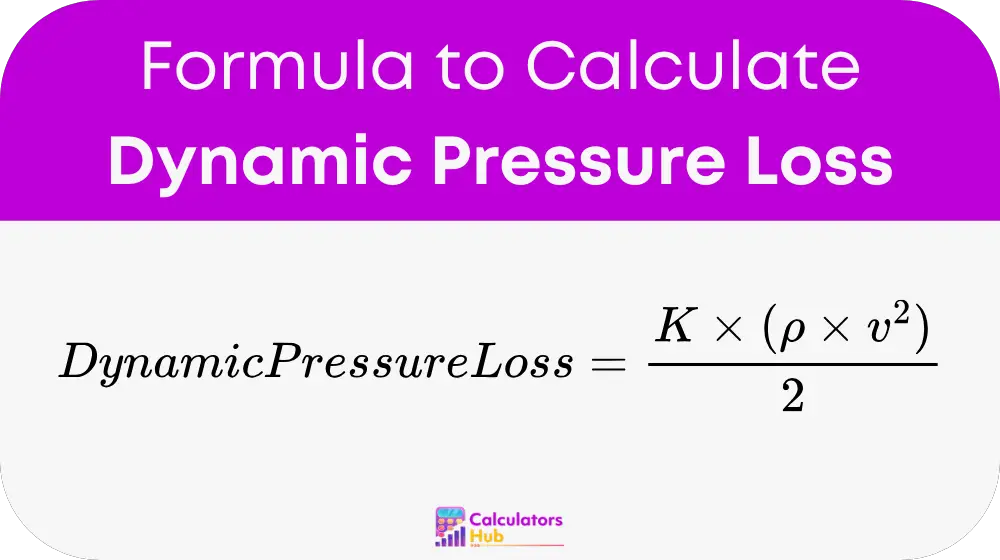The Dynamic Pressure Loss Calculator figures out how much pressure drops when a fluid—like water or air—moves through pipes, fittings, or obstacles. This tool falls under the category of engineering calculators, making it perfect for plumbers, HVAC designers, or anyone working with fluid systems. It helps you understand how much energy gets lost due to things like bends, valves, or changes in pipe size.
Why does this matter? Pressure loss affects how well a system works. Too much loss means pumps or fans have to work harder, costing more energy and money. This calculator helps you spot problems and fix them early. It’s great for real-life decisions, like designing efficient pipes, choosing the right equipment, or keeping systems running smoothly. Plus, it’s reliable for important tasks—like saving costs or ensuring safety in buildings. Want to know how it’s calculated? Let’s dive into the formula next.
Formula for Dynamic Pressure Loss Calculator
The formula for finding dynamic pressure loss is:

Where:
- Dynamic Pressure Loss = Pressure drop (in Pascals, Pa, or psi)
- K = Pressure loss coefficient (a number with no units)
- ρ = Fluid density (kg/m³ for metric, lb/ft³ for imperial)
- v = Fluid velocity (m/s or ft/s)
Pressure Loss Coefficient (K)
K depends on what’s in the pipe:
- 90° elbow: 0.3 to 1.5
- 45° elbow: 0.2 to 0.4
- T-junction: 1.0 to 2.0
- Sudden expansion: (1 - A₁/A₂)²
- Sudden contraction: 0.5 × (1 - A₂/A₁)
Where:
- A₁ = Starting pipe area
- A₂ = Ending pipe area
Velocity Calculation
v = Q / A
Where:
- Q = Flow rate (m³/s or ft³/s)
- A = Pipe area (m² or ft²)
This formula comes from fluid mechanics, a science used in engineering. You multiply the loss coefficient by half the density times velocity squared. Keep units consistent—like metric or imperial—for accurate results. Now, let’s simplify it with a table.
Quick Reference Table for Pressure Loss
Why calculate every time? This table shows pressure loss for common setups, using water (ρ = 1000 kg/m³) and typical K values.
| Fitting Type | Velocity (m/s) | K Value | Pressure Loss (Pa) |
|---|---|---|---|
| 90° elbow | 2 | 1.0 | 2,000 |
| 45° elbow | 3 | 0.3 | 1,350 |
| T-junction | 1.5 | 1.5 | 1,687.5 |
| Sudden expansion | 2 | 0.5 | 1,000 |
How to Use the Table
- Pick your fitting and velocity.
- Find the K value and pressure loss.
- Use it to check your system.
This table helps with searches like “pressure loss in 90° elbow.” For custom numbers, use the formula. Next, let’s try an example.
Example of Dynamic Pressure Loss Calculator
Suppose water flows through a 90° elbow at 2.5 m/s. The water density is 1000 kg/m³, and the K value is 1.2. You want the pressure loss. Here’s how:
- Plug into the formula:
Dynamic Pressure Loss = K × (ρ × v²) / 2
Pressure Loss = 1.2 × (1000 × 2.5²) / 2 - Calculate step-by-step:
- v² = 2.5 × 2.5 = 6.25
- ρ × v² = 1000 × 6.25 = 6,250
- (ρ × v²) / 2 = 6,250 / 2 = 3,125
- K × 3,125 = 1.2 × 3,125 = 3,750
So, the pressure loss is 3,750 Pa. This fits engineering standards and helps you plan your system—like choosing a stronger pump if needed.
Most Common FAQs
Calculating pressure loss shows how much energy your system loses when fluid moves through fittings or pipes. It helps you design systems that work well—like making sure water or air reaches where it’s needed without wasting power or money.
You can find K values in engineering charts or pipe fitting guides online. They depend on the fitting type—like elbows or valves—and how sharp the change is. Most range from 0.2 to 2.0, but check specifics for your setup.
Yes, it works for any fluid—like air or water—just use the right density. Air is lighter (about 1.2 kg/m³), so the loss is smaller than water, but the formula stays the same.